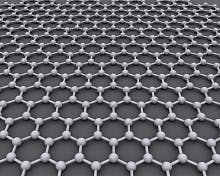The U.S. Department of Energy (DoE) SLAC National Accelerator Laboratory and collaborators have detailed in Nature Communications how spiraling pulses of laser light could change the nature of graphene, turning it from a metal into an insulator and giving it other peculiar properties that might be used to encode information. “It’s as if we’re taking a piece of clay and turning it into gold, and when the laser pulse goes away the gold goes back to clay,” said Thomas Devereaux, a professor at the DoE's SLAC National Accelerator Laboratory and director of the Stanford Institute for Materials and Energy Sciences (SIMES), a joint SLAC/Stanford institute.
RELATED ARTICLE: Light pulses control graphene’s electrical behavior; finding could lead to nw broadband light sensors
"But in this case," he said, "our simulations show that we could theoretically change the electronic properties of the graphene, flipping it back and forth from a metallic state, where electrons flow freely, to an insulating state. In digital terms this is like flipping between zero and one, on and off, yes and no; it can be used to encode information in a computer memory, for instance. What makes this cool and interesting is that you could make electronic switches with light instead of electrons."
Graphene is a pure form of carbon just one atom thick, with its atoms arranged in a honeycomb pattern. Celebrated as a wonder material since its discovery 12 years ago, it’s flexible, nearly transparent, a superb conductor of heat and electricity and one of the strongest materials known. But despite many attempts, scientists have not found a way to turn it into a semiconductor--the material at the heart of microelectronics.
An earlier study demonstrated that it might be possible to take a step in that direction by hitting a material with circularly polarized light--light that spirals either clockwise or counterclockwise as it travels, a quality that can also be described as right- or left-handedness. This would create a bandgap or range of energies that electrons cannot occupy, which is one of the hallmarks of a semiconductor. In the SIMES study, theorists used the DoE’s National Energy Research Scientific Computing Center at Lawrence Berkeley National Laboratory to perform large-scale simulations of an experiment in which graphene is hit with circularly polarized pulses a few millionths of a billionth of a second long.
The simulations show that the handedness of the laser light would interact with a slight handedness in the graphene, which is not entirely uniform. This interaction leads to interesting and unexpected properties, said SLAC staff scientist and study co-author Brian Moritz. Not only does it produce a band gap, but it also induces a quantum state in which the graphene has a so-called "Chern number" of either one or zero, which results from a phenomenon known as Berry curvature and offers another on/off state that scientists might be able to exploit.
While this study does not immediately open ways to make electronic devices, it does give researchers fundamental insights that advance the science in that direction. The results are also relevant to materials called dichalcogenides, a focus around the world because of their potential for creating "valleytronic" devices. In valleytronics, electrons move through a two-dimensional semiconductor as a wave with two energy valleys whose characteristics can be used to encode information.
In addition to SLAC, Stanford, SIMES and the Max Planck Institute for the Structure and Dynamics of Matter, other members of the research team were from Berkeley Lab, the University of Tokyo and Georgetown University. The work was funded by the DOE Office of Science.
SOURCE: SLAC National Accelerator Laboratory; https://www6.slac.stanford.edu/news/2015-05-27-spiraling-laser-pulses-could-change-nature-graphene.aspx?
This article was published by Laser Focus World on 6/10/2015

